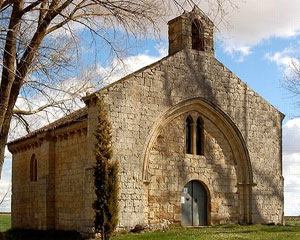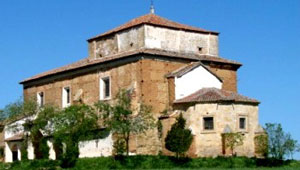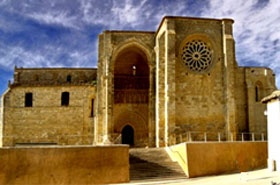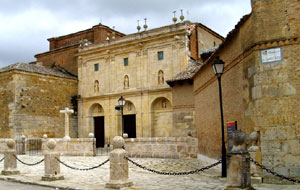Camino de Santiago - French Way - Stage 16 - Frómista to Carrión de los Condes
Total distance: 19.3 km

Leave Fromista on the road heading towards Carrión de Los Condes. In recent years a specially constructed gravel walkway, or andadero de peregrinos, has been added running parallel to this road all the way to Carrión de Los Condes. This route will take you past the outskirts of Población de Campos, where there is a bar and refugio and to the village of Villovieco. It passes through the villages of Villarmentero de Campos and Revenga de Campos and skirts Villalcázar de Sirga. After about 3 kilometres the old route meets the new just after the tiny 13th century Ermita de San Miguel on the left. At this point you can keep following the purpose made path to Carrión de Los Condes or take the old route.
If you want to take the old route then turn right here down towards the Paseo del Cementerio and into Población de Campos. The village here is a good place to see some of the adobe style mud buildings endemic to this area as well as the very large Palomares which are used to breed pigeons. There is also an albergue and a casa rural if you wish to spend the night as well as a shop, restaurant and a couple of bars if you need refreshment.
There isn't much to see here but you may wish to visit the small 13th century Ermita de la Virgen del Socorro and the 17th century church, Iglesia de la Magdelena. There are also the remains of a former pilgrim hospital.

The route continues behind the church where you will come to a junction with a minor road ahead. Follow this for about 3 kilometres where you will come across a fountain on your right hand side with a wayside cross next to it. After another kilometre you should reach the village of Villovieco, don't stop here, just skirt past it. At a bridge over the Rio Ucieza take a left then an immediate right to follow the river bank, this you do for about 5 kilometres until you come to the Ermita de la Virgen del Rio. Inside you will find an alabaster image of Santiago Peregrino and a statue of la Virgen del Rio who is said have swum up the Rio Ucieza during a flood and stopped here. You may need to ask permission to go inside as I believe it is now a private house.
After the Ermita de la Virgen del Rio turn left near the bridge and walk past the Ermita del Cristo de la Salud, again turn left and continue down the path for about 1 killometre until you reach Villalcázar de Sirga, or as it is more commonly known in these parts, Villasirga. It is at this point that the other route converges. In the 13th century the Camino was re-routed through here because King Alfonso X, el Sabio (the Learned) continuously mentioned the miracles performed by the Virgen Blanca (white virgin) in his Cantigas, a large collection of songs from the Middle Ages.

The main monument in Villalcazár de Sirga is la Iglesia de la Virgen Blanca, a large church build between the 12th and 13th centuries by the Knights Templar. This already huge church is what remains of a much larger building which was damaged in 1755 by an earthquake and Napoleon's troops during the Napoleonic wars.
Inside the church are the tombs of Don Felipe, a Templar knight and brother of Alfonso X, el Sabio and his wife Doña Leonor. There are a couple of miracles attributed to items within the church. The first is a statue of the Virgin Mary which is said to heal pilgrims who haven't been healed in Santiago. The second is an alabaster bust of Santiago which is reportable able to get rid of headaches, if you rub a towel across its forehead and then across your own then you will be cured.
For those wishing to stay there is a municipal albergue and some bed and breakfast style hotels and a hostel. The village also has a bakery, a couple of shops, a restaurant and a bar.
From Villalcázar de Sirga we will follow the purpose made gravel track that runs parallel to the road for 5 kilometres until we reach Carrión de los Condes.
Carrión de los Condes during medieval times was a town of between 10,000 and 12,000 inhabitants, nowadays there are just over 2,000. The town also used to have at least 12 churches and several pilgrim hospitals. Some books tell us that the town got its name from a story told in El Canter de Mio Cid about two Castilian nobles or Condes, who married the daughters of Don Rodrigo Diaz de Vivar, El Cid. Once married, the men took the women's fortunes and tied them to trees and beat them. The truth is that the town had belonged to the Leonés royal family and was called la ciudad de los Condes, or city of the Counts.
As you enter the town you will pass la Cuesta de la Mora and its fountain. Legend says that King Alfonso X had arranged to meet with his Moorish lover Zulima for an assignation, but she was late and the King, angry at this perceived slight, cursed the fountain. Unfortunately, Zulima finally turned up and tragically drank from the fountain dying soon after.
One of the monuments of particular interest is the 12th century Iglesia de Santa Maria del Camino which celebrates a victory over the Moors which happened on this site. Each year the Christian inhabitants of the town were forced to pay tribute to their Moorish rulers by providing them with 100 virgins. Understandably they weren't too happy about it and prayed for deliverance. Santa Maria heard their prayers and sent a herd of bulls to attack the Moors and drove them away.

Another building worth visiting is the Monasterio de Santa Clara. This is one of the oldest Claris convents in Spain having been founded in 1255 by the Queen of Portugal and niece of King Fernando III, Mencia. It is rumoured to have sheltered Saint Francis of Assisi on his pilgrimage to Santiago. The convent is now home to one of Carrión de los Condes' albergues and a museum containing some very valuable works of religious art.
There is actually a rather unusual story that surrounds the Convent. During the Napoleonic war the French soldiers and the nuns came to an agreement. The nuns would provide the soldiers with chocolate and picatostes (pieces of fried bread) in exchange for the soldiers leaving them alone and respecting the monastery. It's amazing what people will do for a little bit of chocolate!
There are all the necessary amenities including a supermarket in the town. There are 3 albergues here along with 4 hostels and a nearby camping site called El Eden by the Rio Carrión.
Before you leave Carrión de los Condes make sure you have plenty of food and drink with you as for the next 40 kilometres there will be precious few chances to buy food and there is no water for at least 17 kilometres.

